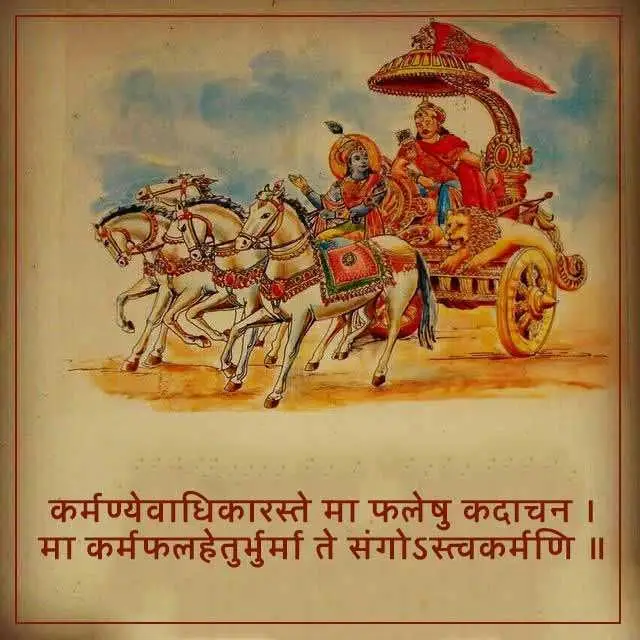Explore five more insightful shlokas from the Bhagavad Gita, complete with full verses, translations, and practical applications for personal growth and spiritual well-being. Learn how these timeless teachings can guide you in modern life.
5 Shlokas from the Bhagavad Gita with Full Verses and Practical Applications
The Shrimad Bhagavad Gita offers profound teachings that apply to every aspect of life, providing guidance on how to live with wisdom, self-awareness, and balance. Here are five more shlokas with full verses, translations, and practical applications for personal growth and spiritual fulfillment.
1. Shloka: Chapter 2, Verse 47
कर्मण्येवाधिकारस्ते मा फलेषु कदाचन। मा कर्मफलहेतुर्भूर्मा ते सङ्गोऽस्त्वकर्मणि॥
Translation: “You have the right to perform your prescribed duties, but you are not entitled to the fruits of your actions. Never consider yourself to be the cause of the results of your activities, nor be attached to inaction.”
Application in Life:
This shloka teaches the principle of detached action, emphasizing the importance of focusing on one’s duties without being attached to the outcome. It encourages a mindset where we focus on the process rather than the results. By doing our work diligently and not worrying about the results, we free ourselves from stress and anxiety.
Example:
When working on a project, instead of constantly worrying about the outcome (promotion, rewards), focus on doing your best and leave the results to unfold naturally.
2. Shloka: Chapter 18, Verse 66
सर्वधर्मान्परित्यज्य मामेकं शरणं व्रज। अहं त्वां सर्वपापेभ्यो मोक्षयिष्यामि मा शुच:॥
Translation: “Abandon all varieties of dharma and simply surrender unto Me. I shall deliver you from all sinful reactions. Do not fear.”
Application in Life:
This shloka emphasizes surrender to the divine will. It teaches that by letting go of ego, fear, and attachment, and by trusting the higher power, we are relieved of our burdens. This surrender brings inner peace, as it removes the weight of overthinking and overanalyzing our problems, letting us flow with the natural rhythm of life.
Example:
In difficult situations, instead of feeling overwhelmed by the choices and outcomes, surrendering the situation to a higher power can bring peace and clarity.
3. Shloka: Chapter 5, Verse 18
विद्या विनयसम्पन्ने ब्राह्मणे गवि हस्तिनि। शुनि चैव श्वपाके च पण्डिता: समदर्शिन:॥
Translation: “The humble sage, by virtue of true knowledge, sees with equal vision a learned Brahmin, a cow, an elephant, a dog, and a dog-eater.”
Application in Life:
This shloka teaches equality and humility, encouraging us to see beyond external differences and to recognize the same divine presence in all beings. It promotes the idea that true knowledge leads to an equal vision and that all forms of life should be respected and treated with compassion.
Example:
In daily life, this can be applied by treating everyone with respect and dignity, regardless of their social status, race, or background.
4. Shloka: Chapter 6, Verse 6
बन्धुरात्मात्मनस्तस्य येनात्मैवात्मना जित:। अनात्मनस्तु शत्रुत्वे वर्तेतात्मैव शत्रुवत्॥
Translation: “For him who has conquered the mind, the mind is the best of friends; but for one who has failed to do so, his mind will remain the greatest enemy.”
Application in Life:
This shloka emphasizes the importance of mastering the mind. It teaches that if we can control our thoughts and emotions, the mind becomes our greatest ally, helping us achieve success and happiness. However, if we allow the mind to control us, it becomes our enemy, leading to frustration and suffering.
Example:
In moments of stress or anxiety, practicing mindfulness or meditation helps regain control over your thoughts, turning your mind into a tool for peace rather than a source of distress.
5. Shloka: Chapter 7, Verse 3
मनुष्याणां सहस्रेषु कश्चिद्यतति सिद्धये। यततामपि सिद्धानां कश्चिन्मां वेत्ति तत्त्वत:॥
Translation: “Out of thousands among men, one may strive for perfection; and of those who have achieved perfection, hardly one knows Me in truth.”
Application in Life:
This shloka teaches the rarity and difficulty of attaining spiritual realization. It encourages us to understand that spiritual growth and self-realization require consistent effort and dedication. It reminds us that while many may seek success in material endeavors, few strive for true self-knowledge and fewer still attain it.
Example:
In the pursuit of goals, it’s essential to balance material achievements with spiritual growth. Practicing self-awareness and meditation can help cultivate a deeper connection with one’s true self.
Conclusion
These additional shlokas from the Bhagavad Gita offer powerful lessons on self-mastery, equality, detachment, and spiritual surrender. By integrating these teachings into our daily lives, we can cultivate a more balanced, peaceful, and purposeful existence.

